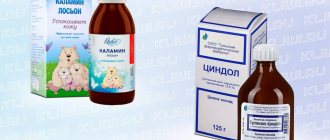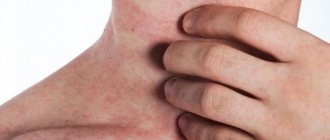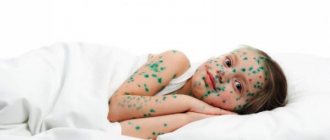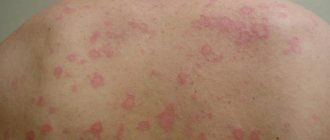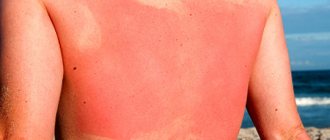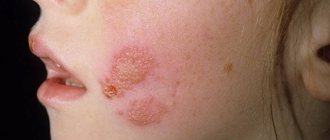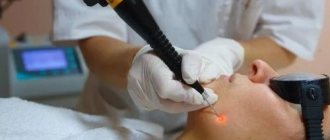Smallpox is an acute, contagious disease caused by the variola virus. Smallpox virus is a member of the genus Orthopoxvirus, family Poxviridae. Virologists suggest that this virus emerged as a result of a mutation of the African rodent poxvirus about 10,000 years ago.
The genomes of viruses of the family Poxviridae consist of double-stranded deoxyribonucleic acid (DNA), these viruses are copied in the cytoplasm of cells. Poxviridae consists of two subfamilies: Chordopoxvirinae (infect vertebrates) and Entomopoxvirinae (infect insects).
Smallpox directly and profoundly affected the course of human history. Smallpox destroyed entire civilizations, including the Incas and Aztecs. These civilizations were destroyed in a single generation, and the efforts made to eradicate this disease have had an indelible impact on religion and medicine.
Types of smallpox
Today there are two main types of smallpox known, natural and varicella. They differ significantly in mortality (30% versus 1%, respectively). Smallpox was responsible for approximately 400,000 deaths per year in Europe (late 18th century). In patients who managed to recover from the disease, blindness and disfiguring scars were among the most common residual effects of the disease.
Smallpox has four subtypes, namely:
- Smallpox is the most common form, accounting for 90% of all cases.
- Modified smallpox is a mild form and develops in previously vaccinated individuals.
- Malignant smallpox is a severe type of smallpox in which the characteristic lesions do not appear on the surface of the skin.
- Hemorrhagic smallpox (fulminant smallpox) is a rare, very severe, and very deadly type of smallpox. With this form, a person develops hemorrhages in the skin and mucous membranes.
Chickenpox is even rarer and much less virulent.
Other types of smallpox include:
- Pulmonary form - characterized by severe symptoms, cyanosis and bilateral infiltration. Mortality from this type is uncertain.
- Pharyngeal form - develops in immunized individuals. This form appears as spots on the soft palate, uvula and pharyngeal mucosa.
- Flu-like forms. They rarely lead to a rash.
Immunization
Targeted inoculation with smallpox strains to protect against the smallpox virus (variolation) was first practiced in India in the first millennium AD. Soon, this practice spread throughout the Old World and eventually reached Europe in the early 18th century. Although lifelong immunity could be induced by variolation, the practice was considered a risky procedure, as approximately 10% of vaccinated individuals died. In addition, vaccinated individuals could transmit the disease to unvaccinated individuals some time after variolation.
And already in 1796, Edward Jenner proved that a person could still get protection from this disease. According to his technique, it is necessary to apply a pustular material containing the cowpox virus, which is closely related to smallpox, to the skin of an unprotected person, as a result of which the person develops heterologous immunity. On the one hand, this immunity did not persist throughout life, but on the other hand, this approach was much safer than variolation. Soon, this type of vaccination quickly spread throughout the world.
And at the end of the 1940s, some of the first synthetic vaccines were already developed. Large-scale production of freeze-dried vaccine enabled mass vaccination campaigns and the eventual global eradication of smallpox. In the second half of the 1960s, the World Health Assembly intensified its efforts to eradicate the disease using potent and stable vaccines, quickly identifying outbreaks, and vaccinating all persons with whom an infected person might come into contact.
The last case of an endemic smallpox outbreak occurred in 1977 in Somalia, which was the last time a person was exposed to the smallpox virus (infection was the result of an accidental laboratory contamination). And already in 1980, the World Health Organization (WHO) officially announced that smallpox had been eradicated. Currently, the only remaining variola virus isolate is frozen and stored in a highly secure facility at the Centers for Disease Control and Prevention (CDC) in the United States and at an institute in Russia. After defeating the disease, routine vaccination against smallpox was stopped.
Bioterrorism
Smallpox is a priority means of bioterrorism:
- Easily spreads and is easily transmitted from person to person
- High mortality rate
- May cause panic and social unrest
- People need specialized skills to manage outbreaks
Etiology
Smallpox is a DNA containing virus, DNA consists of 135-375 thousand base pairs, is copied in the cytoplasm of the host cell. Orthopoxviruses are among the largest and most complex of all viruses. The virion is brick-shaped with a diameter of approximately 200 nm.
Broadcast
The smallpox virus is mainly transmitted through airborne droplets. This transmission occurs through close personal contact (eg, face-to-face contact). Spreading the virus from clothing or blankets can also lead to infection. Smallpox has a lower transmission rate than measles, whooping cough and influenza. Humans are the only natural hosts of smallpox. Animals and insects do not carry the smallpox virus. Pregnant women with smallpox tend to develop the hemorrhagic disease, which may result in premature birth, which will only increase the risk of fetal or newborn death.
Progression of infection
Entry of just a few smallpox virions into the oropharynx or respiratory tract can cause infection. The virus infects macrophages during the first 72 hours of the incubation phase. The virus then migrates to regional lymph nodes, where it will begin to replicate. After this phase, it will try to get into the spleen, bone marrow, and lymph nodes, as a result of which a person may develop fever, toxicosis and other manifestations as early as the eighth day. Finally, the virus will begin to exit from small blood vessels into the dermis and into the submucosa of the oral cavity and pharynx, which will cause a rash.
The spleen, lymph nodes, kidneys, liver, bone marrow and other internal organs may also contain large amounts of smallpox virus. The incubation period is usually 10-12 days, but it can range from 7 to 17 days. Intrauterine infections are rare (in these cases the virus will have a shorter incubation period). The rate of infection spread among close contacts is between 37% and 88%. Those who survive will gain lifelong immunity.
Smallpox. Photo
Manifestations of smallpox.
A child with a rash (smallpox).
A person with severe hemorrhagic smallpox.
A patient with characteristics of an advanced infection, 1965.
A case of smallpox, 1886.
Two-year-old Rahima Banu from Bangladesh. He was the last person officially recorded to have been infected with the smallpox virus (1975).
Smallpox. Symptoms and manifestations
The incubation period of the smallpox virus ranges from 7-17 days (most often in the range of 10-12 days). During the incubation period, patients are not infectious. The prodromal stage lasts 2-4 days and is characterized by the following aspects:
- Fever (38.8-40 °C)
- Strong headache
- Backache
- Pharyngitis
- Nausea
- Vomiting (rare)
- Prostration
- Enanthema on the mucous membranes of the tongue and oropharynx
10% of fair-skinned people with smallpox may develop thin, erythematous rashes during the prodromal phase. Body shedding and subsequent infectivity reach a peak at the onset of enanthem. After a few days, the virus can be found in the respiratory tract, in skin lesions and in contaminated objects. Respiratory infectivity occurs through face-to-face contact, although some outbreaks are now known to have been caused by spread of the virus through ventilation systems.
The characteristic rash begins to develop after the prodromal phase. First, small red macules appear on the face, and then they spread to the limbs and torso. After a few days, small bubbles merge into larger ones, with a diameter of 2 to 3 mm. After 1-2 days, these papules merge into 2-5 mm vesicles.
Most patients with smallpox report severe headaches and back pain. Some patients may develop neuropsychiatric problems (hallucinations, delusions, depression and psychosis, manic-depressive psychosis).
Between 10% and 20% of patients with smallpox develop ophthalmic complications. Conjunctivitis is the most common and appears 5 days after the rash appears. Some patients develop painful pustules and bulbar conjunctivitis. During epidemics, a large number of people may develop ulcers on the corneas.
Between 2% and 5% of children develop osteomyelitis, due to viral invasion of the bone rather than as a result of a secondary infection.
Physical examination
Initial skin lesions appear as small, red spots on the face, mouth/pharynx, and forearms. Soon, they turn into blisters and pustules (within 1-2 days). The patient becomes most contagious at this time. Around this time, mouth ulcers begin to burst and a rash appears on the skin of the face. Typically, this rash will begin to spread to all parts of the body within 24 hours. After this (on the second day), the rash and fever decrease and the patient begins to feel better.
On the third day, the rash turns into raised papules. On the fourth day, these papules fill with a thick, opaque liquid. These papules often have a depression in the center that resembles a navel, which is one of the main distinguishing features of smallpox. At this time, the fever rises again and remains high until scabs form over the papules.
On days 4-7 after the appearance of the rash, the lesions unite into 4-6 mm pustules. Pustules are round and hard to the touch formations. Many of the pustules merge into even larger formations, especially on the face.
Pustules reach their maximum size on the 10th day. By the end of the second week, after the rash appears, most pustules will already have scabs. The scabs will begin to separate and scars will appear on the skin. The person will be contagious until all the scabs come off.
Compared with unvaccinated individuals, vaccinated individuals have less severe toxicity, less severe symptoms, and fewer lesions, which tend to be more superficial and similar to chickenpox.
Rash on the palms and soles of the feet is also common. In comparison, the chickenpox rash has a centripetal distribution on the torso, with less distribution on the palms and soles of the feet.
Most patients with smallpox report severe headaches and back pain. Some patients develop neuropsychiatric symptoms (hallucinations, delusions, depression and psychosis, manic-depressive psychosis).
Treatment of the disease
Treatment of chickenpox in children takes place at home. During the period of intoxication and fever, constant bed rest is prescribed . Typically, the stage lasts for children - up to 5 days, and for adults - longer.
The diet should be moderate. Fried, fatty and smoked foods are excluded. Vegetables – only boiled or stewed. Berries and fruits should not be consumed during skin rashes, as they irritate the stomach.
be gargled with an aqueous solution of furatsilin after each meal . If chickenpox conjunctivitis is present, Acyclovir ointment is applied to the eyes. Rashes on the skin are lubricated with fucorcin, brilliant green or calamine lotion.
It is forbidden to comb or squeeze out bubbles, as scars will form. Particularly itchy areas should be treated with Penciclovir-Fenistil ointment.
You need to wash in the shower very carefully and carefully. It is best to shower after the rash has stopped. It is optimal to douse yourself with a weak warm solution of potassium permanganate , and then not wipe yourself off, but blot your body with a paper or cloth towel.
Treatment of the disease consists of prescribing medications.
- Acyclovir (Virolex, Zovirax) – for children over two years of age. Valciclovir - from 12 years old, Famciclovir - from 18 years old. These medications are toxic, so they are prescribed only by a doctor and only in cases of moderate to severe disease.
- Immunoglobulin – Zostevir. Also prescribed by your attending physician.
- For women during pregnancy and in cases of preventing complications, Novirin or Izoprinoshchin are prescribed.
- For high body temperature - Paracetamol or Nurofen. Aspirin must be taken by children from 12 years of age; earlier it is contraindicated.
- For severe skin itching - antihistamines: Fenistil, Erius, Zodak, Suprastin and others.
If treatment for chickenpox is started in a timely manner, as well as when a severe form of the disease occurs, the prognosis is positive. Complications may occur in people with immunodeficiencies if they underwent chemotherapy before the disease, or in HIV-infected people after undergoing radiation therapy.
For such people and for infants whose mothers fell ill five days or less before birth, even with intensive treatment, the prognosis remains disappointing.
Smallpox. Diagnostics
Trained (and only trained) personnel should obtain fluid and tissue samples from the patient's throat and/or skin abscesses. Further, in Level 4 biological laboratories, these samples can be examined for the presence of virions using electron microscopy, PCR, immunohistochemical analysis, or by growing the virus in live cell cultures. Serological testing may be performed to detect neutralizing antibodies.
Smallpox can be confirmed based on the brick-like shape of the virions. PCR analysis and electron microscopy can be used to examine inactivated samples and therefore will no longer require such a high level of isolation and can therefore be performed in local laboratories.
However, electron microscopy alone will not be able to identify a specific type of smallpox as a member of the genus Orthopoxviruses (almost all of them have the same appearance). In this case, PCR analysis will help; it can be used to identify species and, moreover, with the help of PCR, minor genetic variations in different strains can be distinguished.
Smallpox. Treatment
No known therapy is effective in treating smallpox (all treatments for smallpox are only symptomatic and supportive). Supportive care for patients with symptomatic smallpox infection includes the following:
- The patient should be isolated until all scabs have fallen off (about 3-4 weeks after the rash appears).
- Fluid and electrolyte balance must be maintained (dehydration must be avoided).
- Medicines for fever and pain should be prescribed promptly.
- Medical personnel should ensure that the patient is well fed.
- It is imperative to take care of your skin.
- All complications should be carefully monitored.
- Corneal injuries can be treated with idoxuridine.
The smallpox vaccine is the only known way to prevent smallpox infection. If the vaccine is given within 4 days of exposure, it can prevent or significantly reduce the severity of smallpox symptoms. Today, two types of vaccines are used: bovine vaccine and vaccinia ACAM2000.
The bovine vaccine promotes the development of active immunity against the smallpox virus by inducing specific antibodies. This vaccine contains live vaccinia virus but does not contain variola virus, the virus that causes smallpox. Cowpox is a member of the orthopoxvirus genus, which includes smallpox (variola), cowpox, monkeypox, and other viruses. Once inoculated, the vaccine induces an immune response that will protect against smallpox.
ACAM2000 contains live vaccinia virus. This vaccine works by developing mild infections that stimulate an immune response. This mild infection effectively protects a person from smallpox without actually causing the underlying disease.
All patients must be isolated and vaccinated in the first 4 days after infection. After which it is necessary to start supportive and symptomatic therapy (for example, hydration, good nutrition). Already at this stage, doctors can begin to use certain medications, such as cidofovir.
Secondary bacterial skin infections can be treated with semisynthetic penicillins (nafcillin, oxacillin, dicloxacillin, cloxacillin), first-generation cephalosporins (eg, cefazolin, cephalexin), or clindamycin.
The causative agent of chickenpox
The chickenpox and shingles virus (Varicella-zoster virus) is a type of herpes virus. Since the disease is relatively mild in those children who attend kindergartens, we have developed a calm attitude towards it. However, scientists studied the infection and it turned out that when the virus enters the body, not only the nerve endings and skin are affected, but also the brain, lungs, genitourinary system and digestive tract. In addition, the virus negatively affects the development of the intrauterine fetus. Chicken pox, a photo of which you can easily find on the Internet, will introduce you visually to this disease.
In addition, it is known that the virus can manifest itself in blood diseases, cancer, radiation sickness, and HIV infection. Chickenpox spreads only in human society; animals are immune to it. The virus is highly contagious and humans are 100 percent susceptible to it. The microbe is well transmitted through the air , covering a distance of up to 30 meters. He is not disturbed by the ventilation system, elevator shaft and flight of stairs.
Chicken pox in children and adults
Methods of transmission of chickenpox.
- By droplets, that is, when sneezing, talking, kissing, coughing.
- By contact - when the saliva of an infected person comes into contact with the unprotected skin of a healthy person;
- From mother to fetus during pregnancy, if during this period she became ill with herpes zoster or chickenpox.
Mostly young children suffer from the disease; up to 90 percent of those affected are children from 4 to 7 years old.
An infected person can transmit chickenpox within two weeks of exposure. It becomes contagious a day before the first signs of chickenpox appear, including the entire period until the blisters scattered over the skin turn into dried crusts. Infectivity stops five days after the last pimple appears.
After contracting the virus, 96 percent of the population retains immunity for life; the remaining four percent of other people can get sick again. Remember, not only people who have chickenpox can transmit the virus, but also those who have symptoms of shingles.
The characteristic period of the disease is autumn-spring seasonality , as the body’s defenses weaken. There are also epidemic cycles of chickenpox (that is, a large number of people are affected by the disease).
Smallpox. Complications
Most patients (65-80%) who manage to overcome the infection may develop secondary skin infections. Other complications of smallpox include dehydration and orchitis. Encephalitis occurs in 1 in 500 cases.
Dermatological complications of smallpox:
- Formation of boils and/or abscesses, secondary bacterial infections
- Sepsis
- Pockmarks
Ophthalmological complications of smallpox:
- Blepharitis
- Conjunctivitis
- Ulcers on the cornea
- Keratitis
- Blindness
Orthopedic complications:
- Arthritis
- Osteomyelitis
Respiratory complications:
- Pulmonary edema
- Pneumonitis
- Bronchopneumonia
How to treat
Treatment of chickenpox in the throat is somewhat difficult, because treating vesicles is extremely inconvenient. For treatment, solutions are mainly used to gargle, as well as ointments to lubricate the vesicles. It is worth noting that not only local treatment plays an important role, but also general antiviral therapy, which is carried out for the disease.
How to rinse
Rinsing is the main form of help for a patient with a rash in the mouth. Rinsing will not help eliminate the chickenpox rash, since the resulting vesicles go through their stages of development, and it is no longer possible to stop the pathological process. However, rinsing solutions will keep the oral mucosa and the vesicles themselves clean.
This significantly reduces the risk of bacterial infection and avoids the development of serious complications. Also, the use of local solutions can reduce inflammation and alleviate the course of the disease.
That is why rinsing solutions mainly have an antiseptic effect and have an anti-inflammatory effect. They can be used by both adults and children. It is recommended to gargle with the following means:
“Furacilin” solution – the active substance is the drug nitrofural. One tablet of the drug is diluted in half a glass of hot water until completely dissolved. When there are no more particles left, the solution must be cooled and the oral cavity should be rinsed with it. Rinses can be used three times a day, alternating with treating the rash in other ways.
Oil solution "Chlorophyllipt" - the main active ingredient is the essential oil of eucalyptus cineole. Cineole is an effective herbal antiseptic. To use for chickenpox in the mouth, a few drops of oil (as much as you put in a pipette) are diluted in half a glass of warm water, cooled and gargled four to five times a day.
Calendula tincture is an alcohol-based product based on the flowers and flower calyxes of calendula. This is an effective folk remedy for rinsing. It has a powerful anti-inflammatory effect and helps to cope with unpleasant, painful sensations in the oropharynx. You can use a ready-made product purchased at a pharmacy. Two teaspoons of the medicine are diluted in a glass of warm water and the mouth and larynx are rinsed well with this medicine.
Application of ointments
You can treat the throat with chickenpox not only with gargles, but also with ointments. Mostly ointments help heal the mucous membrane after the blisters burst. Doctors recommend using the following remedies:
- "Solcoseryl" is the main active ingredient, a deproteinized hemoderivative, which helps speed up the regeneration process. With the help of the drug, tissue trophism is maintained in affected areas and cell proliferation is stimulated. You need to lubricate the rash every six hours, alternating with rinses.
- "Kalgel" - the main substance is lidocaine hydrochloride and celpyridinium chloride. The product has an analgesic effect, so it is used mainly at the stage when the blisters are especially sensitive, or have already burst, exposing the mucous membrane. It is necessary to lubricate the surface of the vesicles several times a day.
